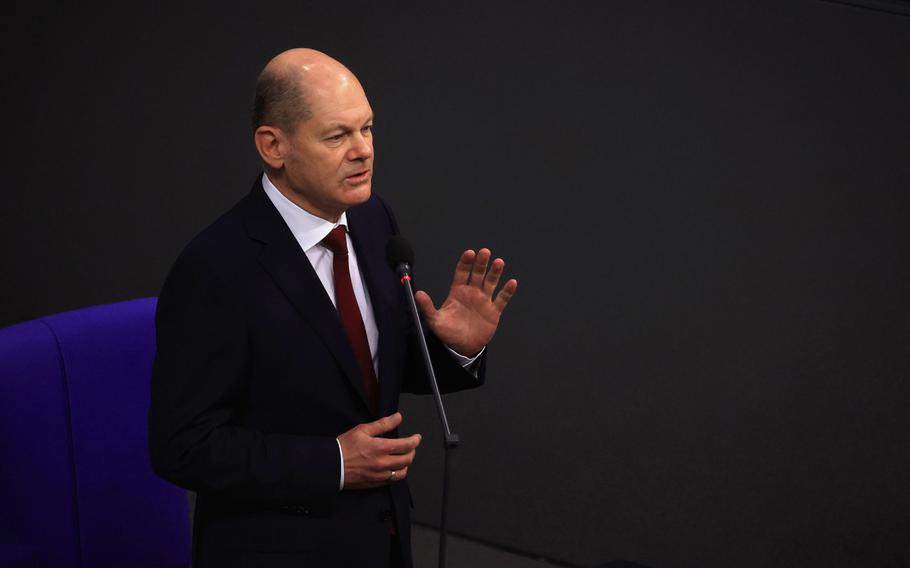Europe
Europe is rearming, and its defense firms stand to profit
Bloomberg February 28, 2022

Olaf Scholz, Germany’s chancellor, speaks at the Bundestag in Berlin on Jan. 12, 2022. (Krisztian Bocsi/Bloomberg)
Germany's pledge to massively ramp up military spending after years of restraint that's left significant parts of its armed forces with outdated equipment is set to boost Europe's defense industry and sent stocks higher.
Europe's largest economy will this year inject $113 billion (100 billion euros) into a special fund to modernize the army, Chancellor Olaf Scholz said Sunday in a speech to the lower house of parliament. From now on, Germany will hit a NATO target of allocating at least 2% of gross domestic product to defense, he told lawmakers in Berlin, a goal the country has consistently failed to meet.
The move sparked gains of as much as 89% for sensor and radar maker Hensoldt in early Frankfurt trading, while Rheinmetall, a producer of tanks and personnel carriers, soared 49% to a record. French fighter jet maker Dassault Aviation jumped as much as 11% while service provider Thales gained 16%.
Defense stocks had already moved higher last week after the Ukraine conflict escalated, fanning concern over Russia's offensive potentially expanding to other nations.
"Non-US NATO members must increase defense budgets by 25% if they want to reach 2% of GDP — clearly Germany represents the largest potential uplift in absolute terms," Jefferies analyst Chloe Lemarie wrote in a research note. "Defense consumables like ammunition and countermeasures should be the first products to experience restocking and order uplift."
Rheinmetall has offered has offered the German government delivery of a package of military equipment that includes ammunition, helicopters and tanks with a value of about $47 billion (42 billion euros), CEO Armin Papperger told Handelsblatt in an interview published Monday. The company is also increasing manufacturing of tank ammunition to 240,000 units a year from about 40,000.
Prior to the conflict erupting, tight military budgets weighed on the defense sector for years, until orders picked up substantially in the wake of Russia's annexation of Crimea in 2014. The deepening conflict in Ukraine could trigger more orders as well as an unblocking of talks to develop a future European combat plane.
Germany rebuffed for years calls for a meaningful increase in defense spending, leading the armed forces across the board to struggle to maintain key technology. Significant parts of defense apparel including fighter jets, tanks and submarines are non-operational because of repairs and problems sourcing replacement parts.
Germany has reduced the number of its battle tanks to 300 from around 5,000 since 1989 and the number of warplanes to 230 from more than 700, according to a report in Der Spiegel magazine.
Allocating the extra funds effectively will require an overhaul of Germany's armed forces, Finance Minister Christian Lindner said Sunday. Slow progress with a range of projects meant spending by the ministry of defense was well below budget last year.
Defense companies will also benefit from a potential shift in Germany's export rules. On Saturday, Germany joined other nations in agreeing to send military equipment to Ukraine, breaking with a traditional rule not to make available German arms to conflict areas.
On Sunday, Scholz urged international cooperation to bolster Europe's ability to defend itself against risks like cyberattacks and remain technologically competitive.
"It's so important to me that we build the next generation of fighter jets and tanks here in Europe together with European partners — and France in particular," Scholz said in his speech. "Until the aircraft are ready for use, we will jointly develop the Eurofighter."
Contracts for the so-called Eurodrone project, a cooperation between Germany, France, Italy and Spain, were signed last week, he said.
"We are also pushing ahead with the acquisition of the armed Heron drone from Israel," Scholz said. Germany will also "procure a modern replacement for the obsolete Tornado jets in time."